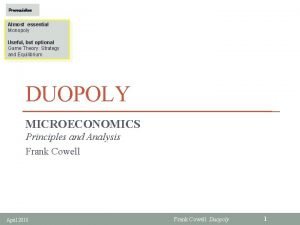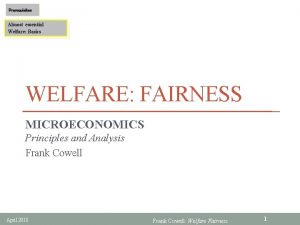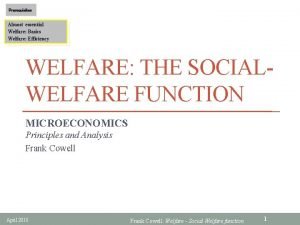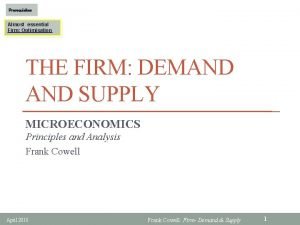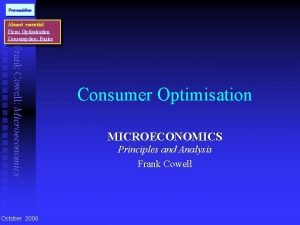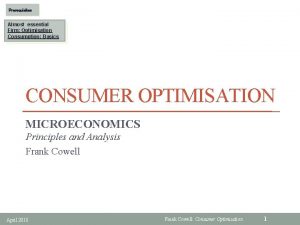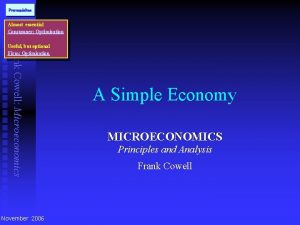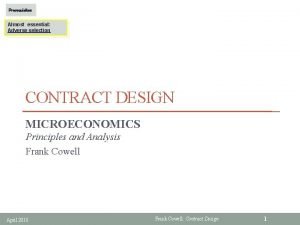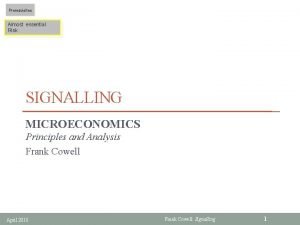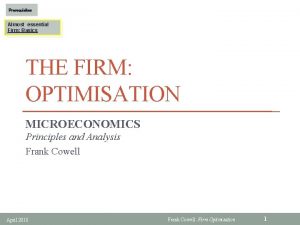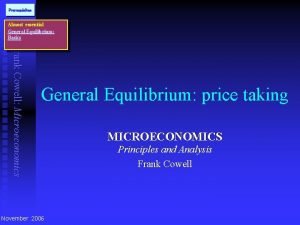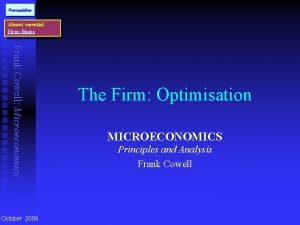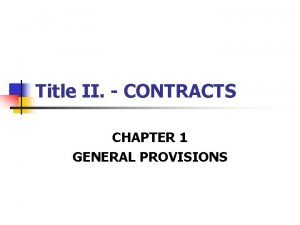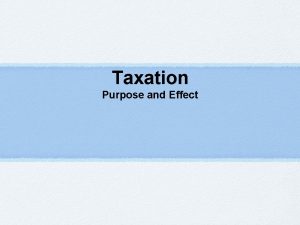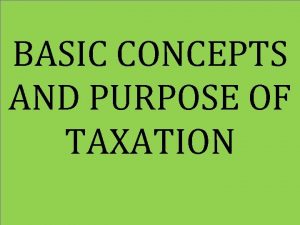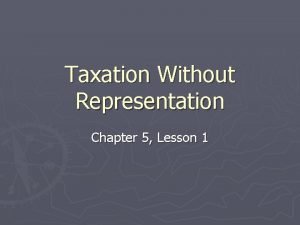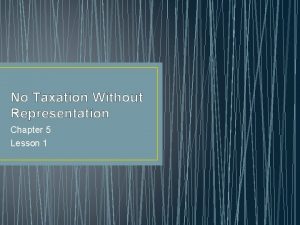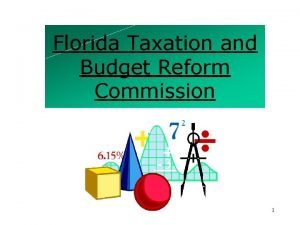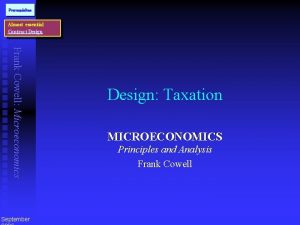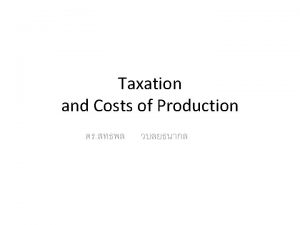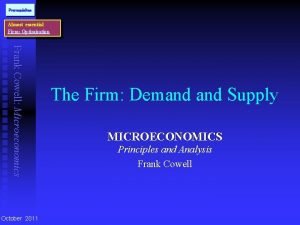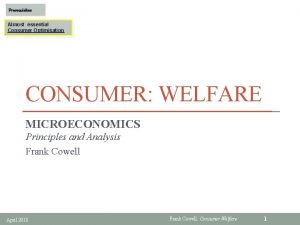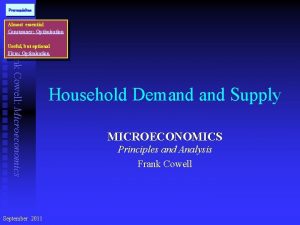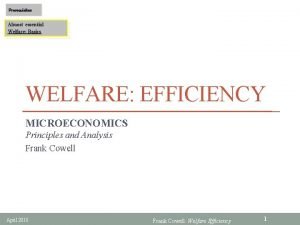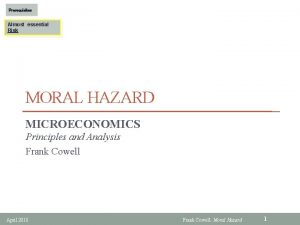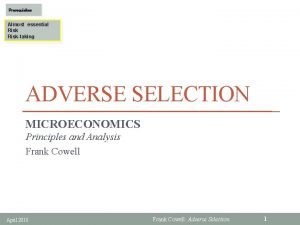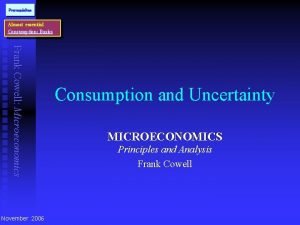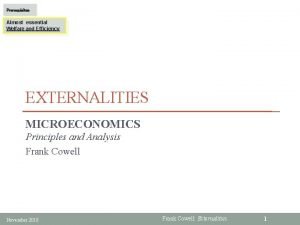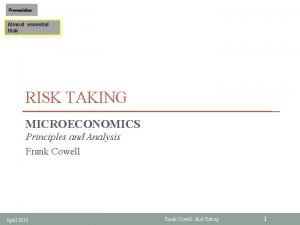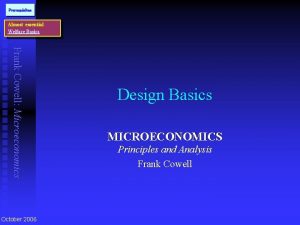Prerequisites Almost essential Design Contract DESIGN TAXATION MICROECONOMICS















![Second-best: two types § The government’s budget constraint • p[qa ya] + [1 p][qb Second-best: two types § The government’s budget constraint • p[qa ya] + [1 p][qb](https://slidetodoc.com/presentation_image_h/189facb8e14a50d1f10b89a1299ad94b/image-16.jpg)











![The continuum model § Continuous ability • bounded support [ , ` ] • The continuum model § Continuous ability • bounded support [ , ` ] •](https://slidetodoc.com/presentation_image_h/189facb8e14a50d1f10b89a1299ad94b/image-28.jpg)









- Slides: 37

Prerequisites Almost essential: Design Contract DESIGN: TAXATION MICROECONOMICS Principles and Analysis Frank Cowell April 2018 Frank Cowell: Design-Taxation 1

The design problem § The government needs to raise revenue • and it may want to redistribute resources § To do this it uses the tax system • personal income tax • and income-based subsidies § Base it on “ability to pay” • income rather than wealth • ability reflected in productivity § Tax authority may have limited information • who have the high ability to pay? • what impact on individuals’ willingness to produce output? § What’s the right way to construct the tax schedule? April 2018 Frank Cowell: Design-Taxation 2

A link with contract theory § Base approach on the analysis of contracts • close analogy with case of hidden characteristics • owner hires manager • but manager’s ability is unknown at time of hiring § Ability here plays the role of unobservable type • ability may not be directly observable • but distribution of ability in the population is known § A progressive treatment: • outline model components • use analogy with contracts to solve two-type case • proceed to large (finite) number of types • then extend to general continuous distribution April 2018 Frank Cowell: Design-Taxation 3

Overview Design: Taxation Design basics Preferences, incomes, ability and the government Simple model Generalisations Interpretations April 2018 Frank Cowell: Design-Taxation 4

Model elements § A two-commodity model • leisure (i. e. the opposite of effort) • consumption – a basket of all other goods § Incomes only from work • individuals are paid according to their marginal product • workers differ according to their ability § Individuals derive utility from: • their leisure • their disposable income (consumption) • Government / tax agency • has to raise a fixed amount of revenue K • seeks to maximise social welfare • where social welfare is a function of individual utilities April 2018 Frank Cowell: Design-Taxation 5

Modelling preferences § Individual’s preferences • u = y(z) + y • u : utility level • z : effort • y : income received • y( ) : decreasing, strictly concave, function § Special shape of utility function • quasi-linear form • zero-income effect • y(z) gives the disutility of effort in monetary units § Individual does not have to work • reservation utility level u • requires y(z) + y ≥ u April 2018 Frank Cowell: Design-Taxation 6

Ability and income § Individuals work (give up leisure) to provide consumption § Individuals differ in talent (ability) • higher ability people produce more and may thus earn more • individual of type works an amount z • produces output q = z, but does not necessarily get to keep this output § Disposable income determined by tax authority • intervention via taxes and transfers • fixes a relationship between individual’s output and income • (net) income tax on type is implicitly given by q − y § Preferences can be expressed in terms of q and y • for type utility is given by y(z) + y • equivalently: y(q / ) + y April 2018 Frank Cowell: Design-Taxation A closer look at utility 7

The utility function (1) § Preferences over leisure and income § Indifference curves § Reservation utility y sing a e r e inc erenc f pre § u = y(z) + y § yz(z) < 0 § u≥u u 1– z April 2018 Frank Cowell: Design-Taxation 8

The utility function (2) y § Preferences over leisure and output § Indifference curves § Reservation utility inc r pre easing fere nce § u = y(q/ ) + y § yz(q/ ) < 0 § u≥u u q April 2018 Frank Cowell: Design-Taxation 9

Indifference curves: pattern § All types have the same preferences § Function y( ) is common knowledge • utility level u of type depends on effort z and payment y • but value of may be information that is private to individual § Take indifference curves in (q, y) space • u = y(q/ ) + y • slope of given type’s indifference curve depends on value of • indifference curves of different types cross once only April 2018 Frank Cowell: Design-Taxation 10

The single-crossing condition § Preferences over leisure and output y § High talent inc r pre easing fere nce § Low talent § Those with different talent (ability) will have different sloped indifference curves in this diagram type b § qa = aza § qb = bzb type a q April 2018 Frank Cowell: Design-Taxation 11

Similarity with contract model § The position of the Agent • not a single Agent with known ex-ante probability distribution of talents • but a population of workers with known distribution of abilities § The position of the Principal (designer) • designer is the government acting as Principal • knows distribution of ability (common knowledge) • the objective function is a standard SWF § One extra constraint • the community has to raise a fixed amount K ≥ 0 • the government imposes a tax • drives a wedge between market income generated by worker and the amount available to spend on other goods April 2018 Frank Cowell: Design-Taxation 12

Overview Design: Taxation Design basics Analogy with contract theory Simple model Generalisations Interpretations April 2018 Frank Cowell: Design-Taxation 13

A full-information solution? § Consider argument based on the analysis of contracts § Given full information owner can fully exploit any manager • pays the minimum amount necessary • “chooses” their effort § Same basic story here • can impose lump-sum tax • “chooses” agents’ effort — no distortion § But the full-information solution may be unattractive • informational requirements are demanding • perhaps violation of individuals’ privacy? • so look at second-best case April 2018 Frank Cowell: Design-Taxation 14

Two types § Start with the case closest to optimal contract model § Exactly two skill types • a > b • proportion of a-types is p • values of a, b and p are common knowledge § From contract design we can write down the outcome • essentially all we need to do is rework notation § But let us examine the model in detail: April 2018 Frank Cowell: Design-Taxation 15
![Secondbest two types The governments budget constraint pqa ya 1 pqb Second-best: two types § The government’s budget constraint • p[qa ya] + [1 p][qb](https://slidetodoc.com/presentation_image_h/189facb8e14a50d1f10b89a1299ad94b/image-16.jpg)
Second-best: two types § The government’s budget constraint • p[qa ya] + [1 p][qb yb ] ≥ K • where qh yh is the amount raised in tax from agent h § Participation constraint for the b type: • yb + y(zb) ≥ ub • have to offer at least as much as available elsewhere § Incentive-compatibility constraint for the a type: • ya + y(qa/ a) ≥ yb + y(qb/ a) • must be no worse off than if it behaved like a b-type • implies (qb, yb) < (qa, ya) § The government seeks to maximise standard SWF • p z(y(za) + ya) + [1 p] z(y(zb) + yb) • where z is increasing and concave April 2018 Frank Cowell: Design-Taxation 16

Two types: model § We can use a standard Lagrangian approach • government chooses (q, y) pairs for each type • subject to three constraints § Constraints are: • government budget constraint • participation constraint (for b-types) • incentive-compatibility constraint (for a-types) § Choose qa, qb, ya, yb to max p z(y(qa/ a) + ya) + [1 p] z(y(qb/ b) + yb) + k [p[qa ya] + [1 p][qb yb ] K] + l [yb + y(qb/ b) ub] + m [ya + y(qa/ a) yb y(qb/ a)] where k, l, m are Lagrange multipliers for the constraints April 2018 Frank Cowell: Design-Taxation 17

Two types: method § Differentiate with respect to qa, qb, ya, yb to get FOCs: • pzu(ua)yz(za)/ a + kp + myz(za)/ a ≤ 0 • [1 p]zu(ub)yz(zb)/ b + k [1 p] + lyz(zb)/ b myz(qb/ a)/ a ≤ 0 • pzu(ua) kp + m ≤ 0 • [1 p]zu(ub) k[1 p] + l m ≤ 0 § For an interior solution, where qa, qb, ya, yb are all positive • pzu(ua)yz(za)/ a + kp + myz(za)/ a = 0 • [1 p]zu(ub)yz(zb)/ b + k [1 p] + lyz(zb)/ b myz(qb/ a)/ a = 0 • pzu(ua) kp + m = 0 • [1 p]zu(ub) k[1 p] + l m = 0 § From first and third conditions: • [kp m ] yz(za)/ a + kp + myz(za)/ a = 0 • kp yz(za)/ a + kp = 0 April 2018 Frank Cowell: Design-Taxation 18

Two types: solution § Solving the FOC we get: • yz(qa/ a) = a • yz(qb/ b) = b + kp/[1 p], • where k : = yz(qb/ b) [ b/ a] yz(qb/ a) < 0 § Also, all the Lagrange multipliers are positive • so the associated constraints are binding • follows from standard adverse selection model § Results are as for optimum-contracts model: • MRSa = MRTa • MRSb < MRTb § Interpretation • no distortion at the top (for type a) • no surplus at the bottom (for type b) • determine the “menu” of (q, y)-choices offered by tax agency April 2018 Frank Cowell: Design-Taxation 19

Two ability types: tax design §a-type’s reservation utility y §b-type’s reservation utility §b-type’s (q, y) §incentive-compatibility constraint §a-type’s (q, y) y §menu of (q, y) offered by tax authority a y §Analysis determines (q, y) combinations at two points b §If a tax schedule T(∙) is to be designed where y = q −T(q) q q April 2018 b q §then it must be consistent with these two points a Frank Cowell: Design-Taxation 20

Overview Design: Taxation Design basics Moving beyond the two-ability model Simple model Generalisations Interpretations April 2018 Frank Cowell: Design-Taxation 21

A small generalisation § With three types problem becomes a bit more interesting • similar structure to previous case • a > b > c • proportions of each type in the population are pa, pb, pc § We now have one more constraint to worry about 1. participation constraint for c type: yc + y(qc/ c) ≥ uc 2. IC constraint for b type: yb + y(qb/ b) ≥ yc + y(qc/ b) 3. IC constraint for a type: ya + y(qa/ a) ≥ yb + y(qb/ a) § But this is enough to complete the model specification April 2018 • the two IC constraints also imply ya + y(qa/ a) ≥ yc + y(qc/ b) • so no-one has incentive to misrepresent as lower ability Frank Cowell: Design-Taxation 22

Three types § Methodology is same as two-ability model • set up Lagrangian • Lagrange multipliers for budget constraint, participation constraint and two IC constraints • maximise with respect to (qa, ya), (qb, yb), (qc, yc) § Outcome essentially as before : • MRSa = MRTa • MRSb < MRTb • MRSc < MRTc § Again, no distortion at the top and the participation constraint binding at the bottom • • determines (q, y)-combinations at exactly three points tax schedule must be consistent with these points § A stepping stone to a much more interesting model April 2018 Frank Cowell: Design-Taxation 23

A richer model: N + 1 types § The multi-type case follows immediately from three types § Take N + l types • 0 < 1 < 2 < … < N • (note the required change in notation) • proportion of type j is pj • this distribution is common knowledge § Budget constraint and SWF are now • Sj pj [qj yj] ≥ K • Sj pj z(y(zj) + yj) • where sum is from 0 to N April 2018 Frank Cowell: Design-Taxation 24

N + 1 types: behavioural constraints § Participation constraint • is relevant for lowest type j = 0 • form is as before: • y 0 + y(z 0) ≥ u 0 § Incentive-compatibility constraint • applies where j > 0 • j must be no worse off than if it behaved like the type below (j 1) • yj + y(qj/ j) ≥ yj 1 + y(qj 1 / j) • implies (qj 1, yj 1) < (qj, yj) and u( j) ≥ u( j 1) § From previous cases we know the methodology • (and can probably guess the outcome) April 2018 Frank Cowell: Design-Taxation 25

N+1 types: solution § Lagrangian is only slightly modified from before § Choose {(qj, yj )} to max Sj=0 pj z (y(qj / j) + yj) + k [Sj pj [qj yj] K] + l [y 0 + y(z 0) u 0] + Sj=1 mj [yj + y(qj/ j) yj 1 y(qj 1 / j)] where there are now N incentive-compatibility Lagrange multipliers § And we get the result, as before • MRSN = MRTN • MRSN− 1 < MRTN− 1 • … • MRS 1 < MRT 1 • MRS 0 < MRT 0 • Now the tax schedule is determined at N+1 points April 2018 Frank Cowell: Design-Taxation 26

A continuum of types § One more step is required in generalisation § Suppose the tax agency is faced with a continuum of taxpayers • frequently used assumption • allows for general specification of ability distribution § This case can be reasoned from the case with N + 1 types • allow N § From previous cases we know • form of the participation constraint • form that IC constraint must take • an outline of the outcome § Can proceed by analogy with previous analysis April 2018 Frank Cowell: Design-Taxation 27
![The continuum model Continuous ability bounded support The continuum model § Continuous ability • bounded support [ , ` ] •](https://slidetodoc.com/presentation_image_h/189facb8e14a50d1f10b89a1299ad94b/image-28.jpg)
The continuum model § Continuous ability • bounded support [ , ` ] • density f( ) § Utility for talent as before • u( ) = y( ) + y( q( ) / ) § Participation constraint is • u( ) ≥ u § Incentive compatibility requires • du( ) /d ≥ 0 § SWF is z (u( )) f( ) d April 2018 Frank Cowell: Design-Taxation 28

Continuum model: optimisation § Lagrangian is ` z (u( )) f( ) d ` +k q( ) − y( ) − K] f( ) d + l [ u( ) − u] ` + m( ) [du( ) / d ] f( ) d where u( ) = y( ) + y( q( ) / ) § Lagrange multipliers are • k : government budget constraint • l : participation constraint • m( ) : incentive-compatibility for type § Maximise Lagrangian with respect to q( ) and y( ) for all [ , ` ] April 2018 Frank Cowell: Design-Taxation 29

Output and disposable income under the optimal tax y _ §Lowest type’s indifference curve §Lowest type’s output and income §Intermediate type’s indifference curve, output and income §Highest type’s indifference curve _ 45° §Highest type’s output and income §Menu offered by tax authority _ q_ April 2018 q q Frank Cowell: Design-Taxation 30

Continuum model: results § Incentive compatibility implies • dy /dq > 0 • optimal marginal tax rate < 100% § No distortion at top implies • dy /dq = 1 • zero optimal marginal tax rate! § But explicit form for the optimal income tax requires • specification of distribution f(∙) • specification of individual preferences y(∙) • specification of social preferences z (∙) • specification of required revenue K April 2018 Frank Cowell: Design-Taxation 31

Overview Design: Taxation Design basics Applying design rules to practical policy Simple model Generalisations Interpretations April 2018 Frank Cowell: Design-Taxation 32

Application of design principles § The second-best method provides some pointers • but is not a prescriptive formula • model is necessarily over-simplified • exact second-best formula might be administratively complex § Simple schemes may be worth considering • roughly correspond to actual practice • illustrate good/bad design § Consider affine (linear) tax system • benefit B payable to all (guaranteed minimum income) • all gross income (output) taxable at the same marginal rate t • constant marginal retention rate: dy /dq = 1 t § Effectively a negative income tax scheme: • (net) income related to output thus: y = B + [1 t] q • so y > q if q < B / t and vice versa April 2018 Frank Cowell: Design-Taxation 33

A simple tax-benefit system §Guaranteed minimum income B y §Constant marginal retention rate §Implied attainable set §Low-income type’s indiff curve §Low-income type’s output, income 1 t §High-income type’s indiff curve §Highest type’s output and income § “Linear” income tax system ensures that incentive-compatibility constraint is satisfied B q April 2018 Frank Cowell: Design-Taxation 34

Violations of design principles? § Sometimes the IC condition be violated in actual design § This can happen by accident: • interaction between income support and income tax • generated by the desire to “target” support more effectively • a well-meant inefficiency? § Commonly known as • the “notch problem” (US) • the “poverty trap” (UK) § Simple example • suppose some of the benefit is intended for lowest types only • an amount B 0 is withdrawn after a given output level • relationship between y and q no longer continuous and monotonic April 2018 Frank Cowell: Design-Taxation 35

A badly designed tax-benefit system §Menu offered to low income groups y y §Withdrawal of benefit B 0 §Implied attainable set §Low-income type’s indiff curve §Low type’s output and income §High-income type’s indiff curve §High type’s intended output and income a y §High type’s utility-maximising choice b § The notch violates IC B 0 §causes a-types to masquerade as b-types q q April 2018 b q a Frank Cowell: Design-Taxation 36

Summary § Optimal income tax is a standard second-best problem § Elementary version a reworking of the contract model § Can be extended to general ability distribution § Provides simple rules of thumb for good design § In practice these may be violated by well-meaning policies April 2018 Frank Cowell: Design-Taxation 37
 Cournot nash equilibrium
Cournot nash equilibrium Almost essential
Almost essential Almost essential
Almost essential Almost essential
Almost essential Almost essential
Almost essential Almost essential
Almost essential Almost essential
Almost essential Shephard's lemma
Shephard's lemma Almost essential
Almost essential Frank cowell microeconomics
Frank cowell microeconomics Almost essential
Almost essential Almost essential
Almost essential What happens at this point?
What happens at this point? Cowell microeconomics
Cowell microeconomics Almost essential
Almost essential Almost essential
Almost essential The firm basics
The firm basics Almost essential
Almost essential Contract assets and contract liabilities
Contract assets and contract liabilities Contingent contract and wagering agreement
Contingent contract and wagering agreement Agreement and contract difference
Agreement and contract difference Essential requirements of a contract
Essential requirements of a contract Title ii contracts
Title ii contracts Essential elements of a contract
Essential elements of a contract Essential non essential fatty acids
Essential non essential fatty acids Canons of taxation
Canons of taxation Effect of taxation
Effect of taxation Absolute taxable capacity
Absolute taxable capacity Classification of taxation
Classification of taxation Legal and ethical issues in ecommerce
Legal and ethical issues in ecommerce Effect of taxation
Effect of taxation Taxation definition
Taxation definition Lesson 1 no taxation without representation
Lesson 1 no taxation without representation Nevada department of taxation
Nevada department of taxation Business taxation syllabus
Business taxation syllabus Chapter 5 lesson 1 no taxation without representation
Chapter 5 lesson 1 no taxation without representation Taxation and budget reform commission
Taxation and budget reform commission No taxation without representation
No taxation without representation
